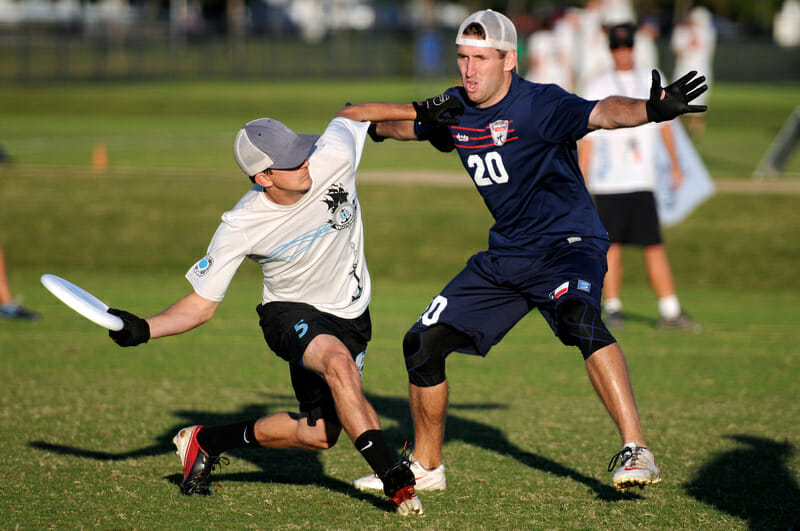Throwing is not optional in ultimate.
July 16, 2015 by Steven Wartinbee in Analysis with 10 comments

Throwing. Alongside catching, defending, and marking, it’s one of the first fundamentals we learn in ultimate, yet only a small segment of the ultimate community are widely considered “elite” throwers.
Ask any of these players what sets them apart, and the answer will be simple: practice. Not just the usual 20 forehands, 20 backhands, repeat 3x, or some such drill. Truly great throwers practice all types of throws in all types of weather. We already discussed how Nethercutt’s skill with the disc was a major factor in this year’s college final; having a truly great thrower is an asset to any team, especially when conditions deteriorate.
There are several specific advantages to throwing every day, or at least as frequently as possible:
1. You practice in all types of weather.
When you set yourself a throwing regimen that isn’t reliant on sunny skies and light or nonexistent wind, you are forced to adapt and learn how the disc cuts through the air in different conditions. The other team is coming zone with a crosswind left? Good thing you practiced your bladey flicks. Crosswind right? Nice time to have a game-ready hammer. This year’s college final was played in winds gusting up to 25mph. One semifinal was played in a cold drizzle. Poor weather doesn’t wait for tournaments to be over.
2. You get time for experimentation.
When you’re throwing daily, you will eventually begin to get bored with the basic throws you’ve mastered, and start to look into which kinds of throws you can add to your arsenal. The best throwers also practice a variety of release points, so that they are comfortable hitting whatever window the mark leaves open. Only game experience can allow you to know when to use which throws (especially when breaking the mark), but having the skill to be able to choose between several different throws to hit the same space will make you virtually unmarkable.
In a recent piece for the MLU, Dusty Rhodes really captured the essence of why having a wide variety of throws is critical, especially at high levels of play: “The puzzle you’re given to solve as a thrower changes over time as the stall climbs. The more weapons you have, the better.”
Perhaps incredibly tight defense has given you no downfield options and clogged your dump set. Having a pinpoint hammer or other bailout throw can get you out of a tough spot that would have likely caused a less skilled thrower to turn the disc.
Out of reset options, the Rhino player below saves the offensive hold with this high-stall huck that drifts perfectly to the breakspace, allowing his receiver to box out and make the play despite close coverage.
http://gfycat.com/VainInfantileBedlingtonterrier
3. You make your teammates more dangerous.
Good throwers throw to open teammates. Great throwers have the ability to throw their teammates open, especially if a defender is marginally out of position but still close, or faceguarding. Tommy Li discusses this in more depth, but having an arsenal of throws that allow you to hit essentially any space on the field is invaluable. Jon Nethercutt exemplifies a thrower with this ability.
http://gfycat.com/CarefulWeakBeetle
A truly elite thrower, especially at the college level, will cause entire teams’ defensive strategies to shift to accommodate him or her. Sometimes this isn’t enough; what use is a force-side poach in the lane if the thrower is just going to break the mark anyway? Even if forced to adopt a more limited role due to poaches, the added pressure on one player allows six others greater freedom to gain free yards and use their own skill sets.
This is especially true if a team has both a highly skilled thrower and very fast/athletic cutter. Who should the other team’s best defender cover?
4. Throws require consistent honing to stay sharp.
Once you develop a throw to the point of being comfortable using it in a competitive game, that’s awesome. Once you stop practicing it frequently, it’s surprising how quickly it can deteriorate. It’s also very important to practice throwing while tired; a throw that is pinpoint Saturday morning is likely to become significantly less accurate by the end of the day as you fatigue. Making sure that you throw consistently immediately after workouts is a good way to combat this.
5. You can spend time developing new throws.
If you’re as busy as most of the general public, and are only throwing infrequently, by the time you finish getting the rust off the throws you do have, chances are you won’t have time to add a throw you’d like to have. Allocating even just 10-15 minutes daily to working on a throw you don’t have will improve it exponentially in the space of just a couple weeks (if your partner doesn’t mind picking up all your errant throws).
6. Ben Wiggins says you should.
From a Reddit AMA of his: “I am going to say this roughly 1 million times in my life, but it bears repeating…Throw Every Day. Steve Nash doesn’t take days off of shooting when he wants to improve. Tony Gwynn didn’t have non-BP days. Heck, how many of the best Halo players ever miss a 24-hour period? If you want to be better than last year, TED is your goal. In my best seasons, I missed 7 and 9 days of throwing in the 365 day span before Nationals.”
7. Throwing doesn’t require rest days.
Unless you’re exclusively trying to throw your maximum distance every time you touch the disc and really straining your shoulder, you should be able to practice every day without significant soreness. For how critical the skill of throwing is to ultimate, that’s a privilege afforded to very few sports. Seize the opportunity to improve.
Now get outside and throw.